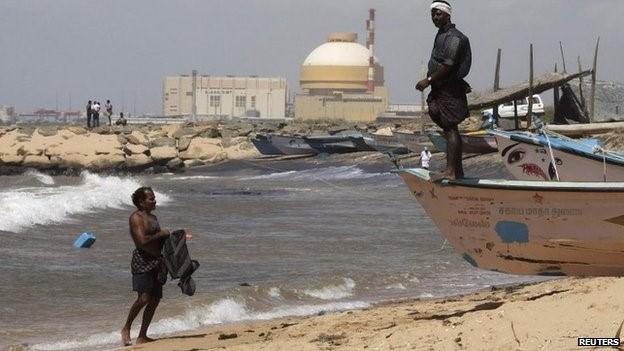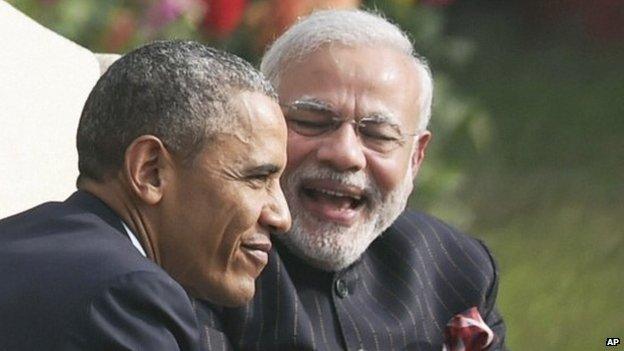Will the India-US nuclear deal work?
- Published

The Kudankulam nuclear plant in India's Tamil Nadu state began producing electricity in 2013
"It's a joyous, happy moment," chimed Abhishek Manu Singhvi, a senior functionary of India's main opposition Congress party, after the US and India announced a breakthrough on a pact that will allow American companies to supply India with civilian nuclear technology.
It was a rare moment of bipartisan support for a deal which came during a heady opening day of President Barack Obama's landmark three-day visit to India.
It was also ironical that the BJP which had steadfastly argued against the nuclear deal in its entirety when in opposition in 2007, had actually managed to pull this off now it is in power. Much of it has been put down to the personal chemistry between Mr Obama and Prime Minister Narendra Modi. It also helps that - unlike his predecessor Manmohan Singh, who was hobbled by difficult allies and reservations about the deal within his own Congress party - Mr Modi suffers from no such constraints.
So how significant is Monday's announcement?
The historic 2006 India-US nuclear deal, external had been held up for eight years amid US concerns over who would be liable for any nuclear accident. Mr Singh, the deal's architect, had told the parliament that it marked the "end of India's decades-long isolation from the nuclear mainstream".
Now, a large insurance pool will be set up, without the need for any further legislation. The plan, according to reports, is to transfer the financial risk to insurers in the case of an accident.
Analysts say the two governments have done "all they can do" and it is now up to the suppliers - or American firms wanting to sell reactor technology to India - to do business.
Energy-hungry India plans to generate 63,000 MW of nuclear power by 2032 - an almost 14-fold increase on current levels. It has 22 nuclear reactors and plans to build some 40 more in the next two decades.
American suppliers are already facing competition. Russia is planning to build 20 reactors in India. France is building six reactors in the western state of Maharashtra, one of India's most industrialised states. America will build at least eight reactors.

The deal has been put down to personal chemistry between Mr Obama and Mr Modi
So what lies ahead for American companies?
"It is not going to be easy. Pricing will be a key issue," says science journalist Pallava Bagla. "New generation American reactors are three times more expensive than comparable India-made reactors. They are also untested as all of them are under construction, including in the US."
Both General Electric and Westinghouse Electric Company, two major US suppliers, have already been given land in Gujarat and Andhra Pradesh state to build reactors, external. Westinghouse has praised developments and said it looked forward to the "fine print" of the agreement and further meetings, including a planned "insurance seminar". GE said it would review the agreement soon.
Clearly, it won't be a walk in the park for American suppliers. It is too early to say that the deal will spur billions of dollars worth of nuclear contracts.
Then there's a strong anti-nuclear lobby in India who fear a disaster similar to the one at Fukushima in Japan in 2011. The controversial Indo-Russian Kudankulam nuclear plant began producing electricity in 2013 after years of protest. India is still far from having non-partisan support for nuclear power.
Also, nuclear power itself presents a mixed picture globally.
There are more than 430 operational reactors in 30 countries around the world. Some 72 are under construction in 15 countries.
Despite new reactors, nuclear power is on the decline. It is generating less than 11% of the world's electricity production, the lowest level since 1982, according to the International Atomic Energy Agency ( IAEA) in its latest report, external. (Coal is still the fuel of choice.) On the one hand, Germany plans to phase out nuclear power by 2022; on the other, China plans to treble nuclear power capacity by 2020, external.
"Nuclear power is at a paradoxical stage," says the IAEA. "On the one hand, it appears to have entered an era of declining expectations. Yet a wave of countries is poised to introduce nuclear power, and the long-term potential remains high." Economic, technological, and political changes, as we have seen, can influence the spread of nuclear power. India is not an exception.